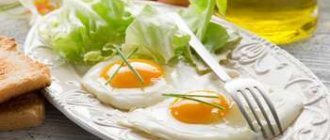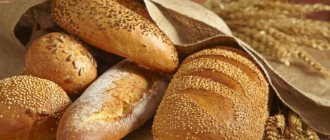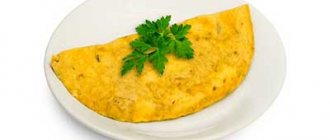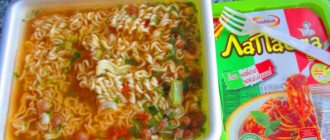The classic omelet, a favorite breakfast dish for the majority of the population of our country, is prepared from eggs beaten with milk, to which just one pinch of salt is added. However, many people prefer thicker omelettes; in this case, wheat or corn flour is added to the preparation.
Be that as it may, dieters argue that the omelette and everything connected with it are not suitable for those who are watching their figure. Let's take a closer look at what an omelet is and how eating it is related to weight loss.
Omelette options
Depending on your imagination and preferences, the omelette can be completely without filling or with ham, and so on; completely exotic fillings are also allowed. Any type of omelet can be mixed together with the selected filling, and the filling can also be wrapped in a finished flatbread.
It is believed that an omelette with meat filling is higher in calories than with fish filling, but this difference is not too significant and should not become an obstacle in choosing the method of preparing this famous dish.
Usually an omelette is cooked in a very hot frying pan, but there are fans who bake the product in the oven, slow cooker or microwave. It cannot be said that due to a different heat treatment, the calorie content of the omelet will decrease.
Calorie content of omelet
Indeed, a ready-made omelet made from 2 eggs with milk in a frying pan or in the oven cannot attract those who want to lose weight with its low calorie content - it is approximately 142.1 kcal per 100 grams.
But this figure is easy to reduce, since a pure protein omelette without milk already boasts a calorie content of 58 kcal for the same weight, which will undoubtedly attract an incredible number of losing weight fans to this dish. Moreover, omelettes are also represented in today’s popular diet programs.
Omelette in dietetics
It is no secret that omelettes have long been used as additives to various diets, including low-calorie diets. This is due to the egg content in them. As you know, eggs contain an incredibly healthy set of vitamins and microelements, such as, and.
In addition, frequent consumption of omelettes helps strengthen the nervous system shaken by diet, which is important for those who have decided to limit themselves in food for the first time. At the moment, there are two diets that are extremely popular:
- hypocaloric
(one egg omelet along with a glass of kefir is added to the breakfast menu); - protein-egg
(omelet with cheese and herbs, made from three eggs, is introduced into the morning diet with one cup of coffee with milk).
It must also be added that the omelet diet not only allows you to quickly lose weight
, but also helps cleanse the body of harmful waste and toxins.
Just remember to completely eliminate
granulated sugar and chocolate.
Classic omelet recipe
Many of us remember the thick and completely unappetizing omelettes of Soviet canteens, but today there is no need to cook them exactly like that - your skillful hands will help you make the perfect classic omelet. To make your omelette truly delicious, choose the following ingredients:
- 1 chicken egg;
- 25 ml milk;
- 3 g table salt;
- 2 g ground black pepper;
- 3 ml sunflower oil.
Place the pan on medium heat and add it to it. stir a little in a deep bowl, then add to it. Beat the mixture with a whisk or in a blender until completely smooth, add pepper and table salt. Stir the mixture again and pour it into the heated frying pan.
Fry the workpiece on one side for about 2 minutes, then turn over with a spatula. Cover the pan with a lid and fry the omelette until cooked, the process will take another two minutes. Calorie content of omelet with milk from 1 egg
per
100 g
is
106 kcal
,
from 3 eggs – 125.1 kcal.
Classic scrambled eggs: calorie content and recipe
Interesting fact: a person eats approximately 173 eggs per year: soft-boiled, hard-boiled, in omelettes and other dishes. But the most popular remains the favorite fried egg, which is consumed in European countries. The highlight of the dish is a solid, non-spreading yolk. This preparation condition is the difference from an ordinary omelet, where eggs are beaten with milk and flour.
The recipe for fried eggs belongs to European cuisine and is so simple that anyone without culinary skills can master it. For one serving you need 10 grams of butter, a frying pan and 2 eggs. In a heated bowl, melt the butter, break the eggs carefully (to avoid damaging the integrity of the yolks), salt, pepper and cook until the whites have coagulated. To protect the body from salmonella at the end of cooking, it is advisable to cover the frying pan with a lid to create steam inside the dish in which the fried egg is fried. A serving of this dish will contain 198 kcal.
Popular omelet recipes
The most delicious, healthy and nutritious omelette can be easily prepared at home, reducing the standard calorie content by adding additional components to the preparation. How to do this is described in the recipes below.
Omelette with tomatoes
A very light and delicious-looking omelette is made with fresh tomatoes and onions. To prepare it, use the following ingredients:
- 2 chicken eggs;
- 100 g onions;
- 200 g tomatoes;
- 25 ml;
- 1 g table salt.
We clean and rinse, then cut it into half rings. After this, put the resulting mass in a heated frying pan and add oil. Fry over medium heat for about five minutes, stirring constantly. While the onion is frying, cut into thin slices.
Add them to the onion and fry the mixture for another minute or two. Meanwhile, beat the eggs a little with salt, then pour the resulting mixture over the cooking vegetables. Fry the omelette for about five more minutes. Calorie content per 100 g
omelette with tomatoes is
76 kcal.
Cheese omelette
Those who love dishes with cheese will certainly appreciate this type of omelet despite the increased calorie content. To prepare it without any problems, choose the following ingredients:
- 1 chicken egg;
- 3 egg whites;
- 25 ml milk;
- 3 ml sunflower oil;
- 50 g;
- 2 g table salt.
Heat the pan in a frying pan using medium heat. Meanwhile, beat the egg with milk, beat the whites separately with table salt. Combine the two resulting mixtures in one bowl, beat in a blender or using a whisk for about a minute.
Separately, grate the cheese on a medium grater. Pour the mixture into a frying pan, sprinkle with grated cheese and cook for about five minutes with the lid closed. Calorie content of omelet with cheese per 100 grams
is
130 kcal.
Omelette with sausage
Sausage is considered a high-calorie product, but few can resist preparing this much-loved dish for breakfast or midday lunch. The omelet turns out perfect if you take the following components:
- 100 g raw smoked sausage;
- 5 chicken eggs;
- 200 ml milk;
- 50 g onions;
- 20 ml sunflower oil;
- 2 g table salt.
In a preheated frying pan, heat the sunflower oil, at this time cut the onion and sausage into cubes. Separately, beat the milk and eggs using a blender, adding a pinch of salt. Pour the sausage and onions into the frying pan, stir with a spatula and fry for about five minutes, trying to prevent the ingredients from burning.
After this, pour the egg-milk mixture onto the sausage, cover the frying pan with a lid and cook the omelette over low heat for about seven minutes. Calorie content of omelette with sausage per 100 grams
is approximately
185 kcal
.
Zucchini omelette
A tender omelette with delicious zucchini is a dietary dish recommended for those trying to lose weight. Baking in the oven makes this dish as light and tasty as possible. Its preparation is impossible without the following components:
We cut the zucchini into thin rings, and try to cut the tomatoes, onions and carrots into half rings. Grease a baking tray or baking dish with oil, place carrots on it, then onions, zucchini and prepared tomato. Sprinkle the dough with salt on top and bake the mixture in the oven for about twenty minutes at a temperature of about 200 degrees.
Meanwhile, prepare the sauce: beat the eggs and whites with a blender, then add water and milk. Beat a little more and remove the vegetables from the oven. Pour them with the prepared sauce and sprinkle with chopped herbs.
Place grated or finely shredded cheese on top and put the pan back in the oven. We keep the product there for approximately ten minutes. Calorie content of omelet with zucchini per 100 g
stays within
75 kcal.
Try to use greens more often
while preparing different types of omelettes. It will not only improve the taste of any dish, but will also greatly contribute to the rapid absorption of food.
Omelette is equally loved by both children and adults. This light, tender, incredibly tasty and nutritious dish is ideal for breakfast, lunch and dinner. It consists of the simplest ingredients that are in every refrigerator, it is prepared in a matter of minutes and even those who are far from culinary art can handle it. In addition, an omelet is an ideal dish for those who are trying to get rid of extra pounds. Firstly, it contains a large amount of protein, the breakdown of which the body spends much more energy and, therefore, loses weight faster, and secondly, it contains very few calories. Speaking of calories. Today we’ll talk in detail about the calorie content of an omelet in different variations of its preparation.
Omelette: cooking secrets
Today only the lazy don’t cook an omelette. But this dish has nothing to do with Russian cuisine. We learned about it thanks to the French. In the Alps there was even a national holiday dedicated to this tender and airy dish. It happened like this: several shepherds woke up before dawn and went to the elder, who was supposed to give the go-ahead to prepare the omelet. After this, local residents unanimously went to the stoves and cooked eggs with milk. Then, with squealing frying pans in their hands, they went out into the street and all danced the farandole together. And then, at a special sign from the elder, the whole honest company went to the meadow, placed the frying pans with the prepared omelet and danced again until sunrise. And only after the bright rays illuminated the entire village, the happy residents dispersed to their homes and ate the prepared omelet with appetite.
Modern French people still have a very reverent attitude towards omelette. For example, did you know that they never beat eggs with a whisk? A real omelette can only be shaken with a fork. Secondly, the French have a separate frying pan for this dish. They don't fry anything on it except their favorite omelet. And after cooking, they first wipe it with bread and only then wash it.
It turns out that making a real omelette is also an art. For example, eggs need to be shaken thoroughly so that they get air. Otherwise, the omelette will be heavy and not airy. And this must be done manually using a fork or whisk. If you use a mixer, you can disrupt the structure of the whites and yolks. And then you won’t see any pomp. If you want to make a dish less calorie, then prepare an omelette from only one protein.
Don't overdo it with milk. Ideally, there should be 1 tablespoon of milk per egg. Otherwise, the dish will be too watery and will fall off.
Another trick is to cook the omelet immediately after you have scrambled the eggs. Otherwise, the omelette will end up flat, like a flatbread.
Pour the egg-milk mixture only onto a hot frying pan. In this case, it should be greased with butter. This is what makes the dish so tender that it literally melts in your mouth.
You need to cook an omelet in the right pan. Thin dishes with a crooked bottom will not work - an omelette will not work on it. It is better to choose a good quality cast iron or Teflon frying pan. And it’s good if there is a special hole in the lid for air. Thanks to this little trick, the dish will not turn out too wet.
Finally, it is necessary to prepare an omelet only from fresh eggs. Dip the purchased eggs in plain water. If they sink immediately, then you are dealing with a fresh product.
Recipe and calorie content of omelet per 100 grams
To determine the calorie content of this tender and tasty egg dish, first we will determine how many calories are in all the ingredients that make up it.
- Eggs - 2 pieces (130 calories)
- Milk 2.5% fat - 60 ml (32 calories)
- Butter for frying 82.5% fat - 10 grams (75 calories).
Since one raw egg weighs on average 60 grams, it turns out that the total weight of the dish was 190 grams, and its calorie content was 237 calories. This means the calorie content of an omelet made from two eggs is 125 calories per 100 grams
. At the same time, it does not matter how the omelette is prepared - in the oven, in the microwave or on the stove. This will not change the calorie content of the dish.
Now let’s calculate the calorie content of an omelet with different fillings and in different variations of its preparation.
Calorie content of a three-egg omelette.
If you prepare an omelet from 4 eggs, then its total calorie content will be 399 calories, and if, on the contrary, you reduce the portion and cook an omelet from one egg and 5 grams of butter, then the calorie content of a delicious breakfast will be 134.5 calories.
Calorie content of omelette with tomatoes
You can add a variety of fillings to an omelette. It can be mixed with the egg-milk mixture and baked or fried in this form. Or you can first prepare an omelette, and then add other ingredients to it and roll it up. Here, as they say, it’s a matter of personal taste preferences. An omelette with vegetables is the most harmonious and dietary combination for those who control their weight and count calories. And among vegetables, the honorable leadership goes to tomatoes.
So, what is the calorie content of an omelet with tomatoes? We take the classic omelette recipe as a basis and add to it 1 medium tomato weighing 50 grams and containing 9 calories (it can be cut into cubes or strips). It turns out that our omelet will weigh 240 grams. And its calorie content will be 246 calories. This means that the calorie content of an omelet with tomatoes per 100 grams is 102.5 calories.
Calorie content of omelette with vegetables
Omelette with vegetables is a healthy and low-calorie dish. What other vegetables can be used to prepare it, besides tomatoes? Nutritionists recommend giving preference to broccoli. For a two-egg omelette, you will need 60 grams of broccoli (20 calories). In this case, the finished dish will weigh 250 grams, and its total calorie content will be 257 calories. Therefore, the calorie content of an broccoli omelette per 100 grams will be 103 calories.
You can also use frozen “Mexican Mix” of vegetables to make an omelet. 60 grams of mixture (34 calories) will be enough. In this case, a finished dish weighing 250 grams will contain 271 calories (108 calories per 100 grams).
Calorie omelette with cheese
Another classic gastronomic combination is the combination of omelet and cheese. To calculate the calorie content of this dish, add 30 grams of grated Russian cheese (105 calories). Then the total weight of the dish will be 220 grams, and its calorie content will be 342 calories. And the calorie content of an omelet with cheese per 100 grams will be slightly higher - 155 calories.
Calorie content of omelette with sausage
For those who prefer heartier dishes, they can prepare themselves an omelette with boiled sausage. Then another item appears in our basic composition - 60 grams of Doctor’s sausage (153 calories). Therefore, in total, the dish will weigh 250 grams, and its calorie content will be 390 calories. This means that the calorie content of an omelette with sausage per 100 grams will be almost the same as in the recipe with cheese - 156 calories.
Calorie content of omelet without milk
To make the dish even more dietary, you can use water instead of milk, which does not have a single calorie. And then the calorie content of an omelet made from two eggs without milk per 100 grams will be 108 calories.
Calorie content of omelet without oil
Butter, like any other butter, is a fairly high-calorie product. Therefore, for those who adhere to food restrictions, you can cook this dish in a dry frying pan or in the oven in a form lined with parchment paper. The calorie content of an omelet without oil will be very small - only 90 calories per 100 grams of product.
Calorie content of egg white omelette
Girls who are on a protein diet usually do not use yolks in preparing omelettes and limit themselves to whites alone. The average egg white weighs 30 grams (13 calories). Accordingly, 2 proteins are 60 grams and 26 calories. It turns out that the calorie content of a protein omelet is 102 calories per 100 grams of dish.
The calorie content of scrambled eggs depends, first of all, on the number of eggs and additional products used as filler. The method of preparation and the amount of oil for frying plays a role.
100 g of raw product contains 155 kilocalories. One egg weighs on average 65-70 g, so one egg contains 110 kcal.
If you cook from one egg using 5 ml of vegetable oil (teaspoon), the nutritional value of the finished dish will be 44 kcal (5 ml of oil for frying) + 110 kcal = 154 kcal.
Based on the above calculation, you can determine the calorie content of fried eggs made from 2 and 3 eggs:
From the presented table you can see how much the energy value of a dish increases depending on the amount of product. For breakfast you need to eat about 500 kilocalories. It turns out that three scrambled eggs will take up most of your morning calories. All this must be taken into account when creating a menu for losing or maintaining weight.
There is a way to prepare it without oil. There are now special non-stick frying pans on sale that allow you to cook with minimal or no oil.
Energy value of scrambled eggs without oil:
Some housewives use margarine instead of vegetable oil for frying, 100 g of which contains 717 kilocalories. To prepare the dish you will need about 5 g of product. Calorie content in margarine will be:
Thus, the energy value of a dish can be reduced by frying it in margarine, although not by much.
Even fewer calories
Everyone knows that to cook scrambled eggs you need vegetable oil, butter or lard, in general, any fat-containing product. But where it is possible to do without it, people do not miss the opportunity to reduce the nutritional value of a dish by removing oil from the recipe. So, scrambled eggs without oil have a calorie content of 45 kcal lower than their classically prepared counterpart, i.e. 125 kcal.
There are several recipes for this dish. The simplest is considered to be scrambled eggs fried in a non-stick frying pan or greased with a drop of oil. Also, lovers of low-calorie dishes came up with the idea of cooking scrambled eggs in water. In this version, the dish is considered the most dietary.
For those who still consider this product high in calories, there is the option of eliminating the yolk, since it contains 3 times more nutrients than the white.
Are scrambled eggs with vegetables lower in calories?
It is believed that scrambled eggs with tomatoes and other vegetables are lower in calories. In fact, this is not entirely true, since additional ingredients are added to the basic set. But in this case, the energy value will increase slightly, since most vegetables are the most dietary and low-calorie foods.
So, for example, the calorie content of scrambled eggs from 2 eggs and one tomato will be:
220 + 44 (5 ml oil) + 9 (1 small tomato) = 273 kilocalories
The difference between regular scrambled eggs (264 kcal) and with the addition of tomatoes (273 kcal) is insignificant, but you can get much more benefits from the second option. Firstly, the diet must include vegetables (fresh ones are preferable, of course). Secondly, the portion will increase due to the filler, and the dish will be more satisfying, which is important for those losing weight.
Energy value with tomatoes:
If you fry scrambled eggs with tomatoes, but without adding oil, you will get a healthy low-calorie dish. Compared to the classic version, the nutritional value will decrease by as much as 40-50%:
From plant products, greens, sweet peppers, and sometimes onions are also added to scrambled eggs. So, by adding a few sprigs of parsley, the nutritional value will increase by only 5-7 kilocalories, sweet bell pepper - by 10 calories, onion - by 8.
The dish can be prepared with frozen vegetable mixture. 100 g of Mexican mixture (green beans, peas, corn, peppers, carrots) contains 87 kcal. If you add 50 g of the mixture, the nutritional value will increase by 46.5 kilocalories.
Popular food combinations with fried eggs
Chicken eggs are considered a universal product. In addition to consumption on their own, they are also used in cooking as a binding component in sauces and cutlets. The chicken product is baked, fried, boiled, and dissolved.
The combination of one chicken egg with 30 g of bacon is considered the most energetically valuable - 210 kcal; the most dietary - scrambled eggs with tomatoes, calorie content - 120 kcal.
The combination of products with which an egg is combined in taste is great: these can be mushrooms, meat ingredients, cheeses, vegetables, and herbs. Each additionally added product increases the energy value (if it is not vegetables, of course). For example, scrambled eggs with sausage have a calorie content of 194 kcal. If you replace a meat product with vegetables, then the food immediately reduces its nutritional value to 110-120 kcal.
The benefits and harms of different types of fried eggs
The benefit of scrambled eggs lies in the composition of the product itself, which is a valuable source of protein and leucine. One egg contains up to 15% of the daily protein requirement. The composition also includes essential minerals and trace elements:
- vitamins A, E and D;
- vitamins B12, B3, folic acid (B9), biotin (B7), choline (B4);
- potassium, magnesium, phosphorus, selenium, calcium, iron.
It should be borne in mind that not all beneficial substances contained in eggs are well absorbed. For example, the product is not suitable for replenishing the daily requirement of calcium - for this you need to eat about forty eggs daily.
The way you prepare a dish, be it the usual version, a fried egg or an omelette, does not affect the benefits your body receives. In this regard, the method of heat treatment plays a role. A dish baked in the oven or microwave will be healthier. The same can be said about a steam omelette.
As for the harm that consumption of fried eggs can cause, it should be noted, first of all, the high fat content of the dish. In addition, yolks are rich in cholesterol, so they should not be consumed by people with hypercholesterolemia.
It should also be remembered that eggs are allergenic products, so they are contraindicated for people with individual intolerance to the product and during allergic reactions to other agents.
Frequent consumption of eggs and dishes made from them increases the load on the kidneys and liver. For diseases such as pancreatitis, cholecystitis, diabetes, etc., the possibility of including the product in the menu should be agreed with the attending physician.
How to reduce the calorie content of scrambled eggs?
To reduce the calorie content of a dish, you need to adhere to the following recommendations:
- beat the egg mixture before frying;
- prepare white scrambled eggs or omelet, separating the yolks;
- use non-stick cookware and cook without oil;
- reduce the number of eggs and add more vegetables and herbs.
Dietary white scrambled eggs with cheese
Scrambled eggs made from whites with the addition of cheese turn out to be very appetizing and incredibly tasty, while it does not harm the figure.
Ingredients:
- 2 eggs (100 g protein – 44 kcal);
- 20 g of Gaudette cheese (100 g - 199 kcal);
- milk 2.5% - 15 ml;
- 10 g parsley.
Preparation:
- Separate the whites from the yolks, beat in a bowl with milk;
- Chop the greens;
- Pour the protein mixture into a non-stick frying pan;
- Sprinkle with grated cheese and herbs;
- Fry over low heat until done.
Calorie content: 80 kcal.
Scrambled eggs with green beans
Even a gourmet will love this dish! It has a rich vegetable flavor and is also very filling.
Ingredients:
- 1 egg;
- green beans – 50 g (in 100 g – 31 kcal);
- salt - to taste.
Preparation:
- Lightly fry 50g frozen beans in a non-stick frying pan;
- Break an egg into it;
- Add salt to taste;
- Cook for another 3-4 minutes on low heat.
Calorie content: 165.5 kcal.
We also present to your attention a step-by-step video recipe:
Classic scrambled eggs are difficult to classify as a dietary dish, but a few simple rules will help reduce their calorie content:
- About 30% of calories can be removed by cooking without oil (in a non-stick frying pan);
- It is better to use vegetables (tomatoes, green beans, peas) as a filler;
- White scrambled eggs or omelet are the “lightest” version of the dish.
We must not forget about contraindications: excess protein in the diet can cause problems with the kidneys and liver. Eggs are contraindicated for persons with individual intolerance to the product.
The question of how many calories are in a fried egg interests all people who take a responsible approach to their diet. It is difficult to imagine a more frequently used product in almost all cuisines of the world than eggs. They serve as an ideal breakfast, a favorite ingredient in salads, snacks and an integral part of many types of dough.
In addition, eggs have many beneficial properties:
- Each egg contains high-quality protein that is quickly digestible by humans, which serves as a building material for muscle tissue.
- The amino acid leucine present in the composition reduces the overall level of toxins on the walls of blood vessels.
- Folic acid, which is especially necessary for pregnant women.
- The presence of microelements important for human life: vitamins B, A, E, D, potassium, phosphorus and many others.
In addition to its composition, eggs are characterized by good digestibility - depending on what heat treatment it was subjected to, it reaches 98%. Eggs are good for vision, teeth and bone tissue, as well as the prevention of cancer and cardiovascular diseases. With all this, the product is considered dietary.
However, there is a downside to the coin in the form of potential harm to eggs:
- They are a source of acute intestinal infection salmonellosis in raw form. It is highly recommended to wash your hands after handling uncooked eggs.
- The claim is controversial, but some scientists claim that egg yolk contains dangerous cholesterol.
- Antibiotics that support the life of chickens on farms.
- Eggs contain nitrates.
- Hormones in eggs - in fact, their amount does not exceed the amount in the meat of various birds and animals.
Scrambled eggs with tomatoes calorie content
Cut onions into half rings, tomatoes into cubes. First fry the tomatoes in vegetable oil, then the onions. Break eggs into a frying pan, add salt and pepper. Fry the scrambled eggs over low heat, piercing the bottom crust with a knife. Scrambled eggs with tomatoes are ready.
Nutritional value and chemical composition of “Scrambled eggs with tomatoes”
The energy value of Scrambled eggs with tomatoes is 124.9 kcal.
Primary Source: Created in the application by the user. Read more.
** This table shows the average levels of vitamins and minerals for an adult. If you want to know the norms taking into account your gender, age and other factors, then use the “My Healthy Diet” application.
Product calorie analysis
Ratio of proteins, fats and carbohydrates:
Benefits of Scrambled Eggs with Tomatoes
- Vitamin A
is responsible for normal development, reproductive function, skin and eye health, and maintaining immunity. - Vitamin B2
is involved in redox reactions, helps to increase the color sensitivity of the visual analyzer and dark adaptation. Insufficient intake of vitamin B2 is accompanied by impaired condition of the skin, mucous membranes, and impaired light and twilight vision. - Choline
is part of lecithin, plays a role in the synthesis and metabolism of phospholipids in the liver, is a source of free methyl groups, and acts as a lipotropic factor. - Vitamin B5
is involved in protein, fat, carbohydrate metabolism, cholesterol metabolism, the synthesis of a number of hormones, hemoglobin, promotes the absorption of amino acids and sugars in the intestines, and supports the function of the adrenal cortex. A lack of pantothenic acid can lead to damage to the skin and mucous membranes. - Vitamin B12
plays an important role in the metabolism and transformation of amino acids. Folate and vitamin B12 are interconnected vitamins that are involved in hematopoiesis. A lack of vitamin B12 leads to the development of partial or secondary folate deficiency, as well as anemia, leukopenia, and thrombocytopenia. - Vitamin D
maintains calcium and phosphorus homeostasis and carries out the processes of bone tissue mineralization. A lack of vitamin D leads to impaired metabolism of calcium and phosphorus in the bones, increased demineralization of bone tissue, which leads to an increased risk of developing osteoporosis. - Vitamin H
is involved in the synthesis of fats, glycogen, and amino acid metabolism. Insufficient consumption of this vitamin can lead to disruption of the normal condition of the skin. - Vitamin PP
is involved in redox reactions of energy metabolism. Insufficient vitamin intake is accompanied by disruption of the normal condition of the skin, gastrointestinal tract and nervous system. - Phosphorus
takes part in many physiological processes, including energy metabolism, regulates acid-base balance, is part of phospholipids, nucleotides and nucleic acids, and is necessary for the mineralization of bones and teeth. Deficiency leads to anorexia, anemia, and rickets. - Chlorine
is necessary for the formation and secretion of hydrochloric acid in the body. - Iron
is part of proteins with various functions, including enzymes. Participates in the transport of electrons and oxygen, ensures the occurrence of redox reactions and activation of peroxidation. Insufficient consumption leads to hypochromic anemia, myoglobin deficiency atony of skeletal muscles, increased fatigue, myocardiopathy, and atrophic gastritis. - Cobalt
is part of vitamin B12. Activates enzymes of fatty acid metabolism and folic acid metabolism. - Copper
is part of enzymes that have redox activity and are involved in the metabolism of iron, stimulates the absorption of proteins and carbohydrates. Participates in the processes of providing oxygen to the tissues of the human body. Deficiency is manifested by disturbances in the formation of the cardiovascular system and skeleton, and the development of connective tissue dysplasia. - Selenium
is an essential element of the antioxidant defense system of the human body, has an immunomodulatory effect, and is involved in the regulation of the action of thyroid hormones. Deficiency leads to Kashin-Beck disease (osteoarthritis with multiple deformities of the joints, spine and limbs), Keshan disease (endemic myocardiopathy), and hereditary thrombasthenia.
still hide
https://www.youtube.com/watch?v=YMfUeJCbsEQ
You can see a complete guide to the healthiest foods in the “My Healthy Diet” app.
Calorie content of scrambled eggs from 2 eggs
Few people have the willpower to get up early in the morning and make a full breakfast. Many people are content with a dish that takes five minutes to prepare. It is clear that we are talking about fried eggs. But won't consuming it lead to extra pounds? We'll find out if we count how many calories are in a scrambled egg made from two eggs.
Calories for breakfast
Determining the calorie content of scrambled eggs from 2 eggs is quite simple, because unlike multi-component dishes, it only has one or two ingredients. Energy value indicators depend on the mass of eggs. They can be small or large.
It is generally accepted that the weight of a medium-sized one is 58 g. Thus, two will weigh 116 g. 100 g of protein-yolk mass contains 157 kcal, that is, one medium-sized raw egg has about 91 kcal, and two, respectively, 182.
If its mass is slightly less - 47 g, then it will contain 73.8 units of energy.
Two-thirds of this reserve is contained in the yolk, the rest is in the white. This distribution of calories will become clear if you look at what is inside the white and yolk. The first is 90% water, 10% is protein, the second includes fat (11.6 g) and cholesterol (139 mg).
Today, thanks to non-stick cookware, you can fry without a drop of fat. A standard scrambled egg of 2 eggs, cooked without oil, will have a calorie content of 148-182 kcal. The average is 167 kcal.
This is almost 10% of the safe daily value, which is quite a bit. That is, it can be called dietary - unless, of course, it is included in the menu for breakfast, lunch and dinner.
If you take small eggs, which contain 61 kcal, you will be able to reduce the number of calories in the fried egg to 122.
Without deviating from the recipe: calorie content of fried eggs in butter
Not everyone has a frying pan in their kitchen cabinet on which nothing sticks. Therefore, many people still cook fried eggs with vegetable or animal fat.
They have a very high energy potential - up to 900 kcal per 100 g. Therefore, you should not expect that dishes fried using them will remain low in calories.
A scrambled egg made from 2 eggs in butter will have the following calorie content:
- if you take small eggs and a minimum portion of butter - 167 kcal, if you take medium ones - 182 kcal;
- if you take large eggs and a spoonful of sunflower oil - 242-250 kcal. Super-healthy olive oil is no different from it in terms of energy intensity - just like expensive flaxseed;
- the use of cream will further increase the satiety of the food and add 10 kcal to it, bringing the total calorie content of the express breakfast to 250-260 kcal.
Supplements - from the most nutritious to the least caloric
To make their breakfast tastier, many people fry a dish with cheese, thus adding 50-90 kcal and “eating” 300-342 kcal in one sitting.
If you add fried sausage or ham, this will cause the calorie content to rise to 400-500 kcal, which is already a quarter of the daily requirement.
Therefore, in order to turn ordinary scrambled eggs into a low-calorie culinary masterpiece, it is better to add vegetables to it - it will be both satisfying and dietary.
The most popular low-calorie additive is tomato: it contains only 20 kcal per 100 g. Let's say there are scrambled eggs with tomatoes on your plate. Let's calculate its calorie content for 2 small eggs:
- eggs – 146 kcal;
- tomato – 25 kcal;
- sunflower oil 1 tsp. – 45 kcal;
- salt – 2 kcal.
How many calories are in an egg if you fry it in oil?
It was said above that eggs are a dietary product. But this applies to those eggs that are prepared by boiling. But many people, including supporters of a healthy diet, love to eat scrambled eggs. So, the question becomes relevant about the calorie content of this product if it is fried.
The energy value in this case will depend not only on the composition of the egg, but also on some other factors:
- egg size;
- type and amount of oil, if used.
Eggs, like chickens, come in different varieties. Weight ranges from 50 to 70 grams. The energy value of 100 grams of raw egg is 70 calories.
Frying in sunflower oil
To fry one egg, 10 grams of oil is enough. 100 grams of it contain 880 calories, which comes out to 10 - 88. But not everything is so simple in calculations. Due to the chemical reactions during this heat treatment, the calorie content increases and ranges from 180 to 220 calories depending on the weight of the egg and provided that no more than 10 grams of oil are used. By comparison, a hard-boiled egg contains only about 50 calories.
Frying in butter
100 grams of butter with a fat content of about 80% contains approximately 700 calories. To fry one egg, 5 grams of this product is enough, and the energy value of the finished dish is about 200 calories. In defense of such large numbers, I would like to say that butter adds a special tenderness and piquancy to any dish, and eggs are no exception. Therefore, even adherents of a healthy diet can occasionally enjoy such a breakfast.
Fry without oil
Scrambled eggs are a favorite product of men, children and many women. It is indecently easy to prepare and any novice housewife can do it. Needless to say, the time from raw product to finished product is only a few minutes, which is very helpful in a hurry or when you are very hungry. However, not all people can afford fried eggs due to diet or health conditions. Fortunately, technological progress has gone so far that literally every home has a non-stick frying pan among its kitchen utensils. The surface of most multicookers also serves as an alternative. This is a real find for healthy eating without giving up your favorite foods.
The calorie content of an egg fried on a non-stick coating without oil is exactly the same as a boiled one. That is, 155 calories per 100 grams of product and approximately 90 per medium egg.
Calories in scrambled eggs - How many calories are in scrambled eggs?
This universally recognized dish has gained honor and respect among all... absolutely all people on the planet! But not everyone knows about the calorie content of scrambled eggs!
Calorie content of fried eggs
The calculation is carried out with the addition of sunflower oil: 1 spoon.
1 egg (75 kcal) + butter (40 kcal) = 115 kcal.
2 eggs (150 kcal) + butter (40 kcal) = 190 kcal.
3 eggs (225 kcal) + butter (40 kcal) = 265 kcal.
4 eggs (300 kcal) + butter (40 kcal) = 340 kcal.
Calorie content of scrambled eggs without oil
It's very easy to calculate! You should subtract the calorie content of vegetable oil.
The result is in scrambled eggs without oil:
- from 1 egg = 75 kcal.,
- from 2 eggs = 110 kcal.,
- from 3 eggs = 185 kcal.,
- from 4 eggs = 260 kcal.
How many calories are in scrambled eggs per 100 grams of product?
On average 232 kcal. per 100 grams of scrambled eggs.
Do you like to add your favorite accompaniments to your eggs? Then look at the following results of the calorie content of scrambled eggs.
How many calories are in scrambled eggs with boiled sausage?
Contains boiled sausage (100 grams) + a spoonful of vegetable oil.
1 egg (75 kcal) + butter (40 kcal) + boiled sausage (250 kcal) = 365 kcal.
2 eggs (150 kcal) + butter (40 kcal) + boiled sausage (250 kcal) = 440 kcal.
3 eggs (150 kcal) + butter (40 kcal) + boiled sausage (250 kcal) = 515 kcal.
4 eggs (150 kcal) + butter (40 kcal) + boiled sausage (250 kcal) = 590 kcal.
Calorie content of scrambled eggs with tomatoes
Contains 1 tomato (100 grams) + a spoon of vegetable oil.
1 egg (75 kcal) + butter (40 kcal) + tomato (20 kcal) = 135 kcal.
2 eggs (150 kcal) + butter (40 kcal) + tomato (20 kcal) = 210 kcal.
3 eggs (225 kcal) + butter (40 kcal) + tomato (20 kcal) = 285 kcal.
4 eggs (300 kcal) + butter (40 kcal) + tomato (20 kcal) = 360 kcal.
How many calories are in scrambled eggs with sausage?
Ingredients: 1 sausage (60 grams) + a spoon of vegetable oil.
1 egg (75 kcal) + butter (40 kcal) + sausage (260 kcal) = 375 kcal.
Ingredients: 2 sausages (120 grams) + a spoonful of vegetable oil.
2 eggs (150 kcal) + butter (40 kcal) + 2 sausages (520 kcal) = 710 kcal.
Ingredients: 3 sausages (180 grams) + a spoonful of vegetable oil.
3 eggs (225 kcal) + butter (40 kcal) + 3 sausages (780 kcal) = 1045 kcal.
You can add onions, cheese, bacon to scrambled eggs and calculate the calorie content
In 100 grams:
- green onions = 19 kcal.,
- onions = 42 kcal.,
- cheese (on average) = 350 kcal.,
- bacon = 400 kcal.
Everything that connects a person and a scrambled egg
It is quite common for people to eat eggs or simple scrambled eggs for breakfast. And this happens for a reason. It's a matter of several things. First, you should point out that in the morning a person wants to stay in his bed as long as possible, therefore, he does not have much time to prepare his breakfast.
Scrambled eggs are prepared so quickly and easily that God himself ordered them to be cooked in the morning!
It has a fairly pleasant taste, and this dish is also very filling. So, after eating just one or two eggs, you will not experience an overwhelming feeling of hunger until the lunchtime meal.
Egg mechanism
Here is the mechanism. An egg contains a white and a yolk, and we have long known that both of these substances are extremely important for our body.
At the same time, protein is very well absorbed by our body, which only benefits the body. The yolk contains a very large number of different polyunsaturated acids, which our body so needs.
So eggs provide us with the necessary proteins that our body cannot produce on its own.
Eggs are considered one of the most environmentally friendly products; they contain many antioxidants and microelements, and they are also the most natural. However, now it’s worth focusing your attention on fried eggs - how many calories do they contain? This information will be especially interesting for those who cannot imagine their morning without a good scrambled egg.
Meanwhile, eggs have quite a high calorie content
More precisely, many calories are contained in the yolk - for one hundred grams of egg you can count on 232 (two hundred thirty-two) calories.
But you can reduce the calorie content of a fried egg much more significantly if you cook it in a non-stick frying pan without using fat or oil.
No matter what, calories from eggs only benefit a person, because they are easily absorbed by the body and carry with them a huge amount of useful microelements and substances.
By eating eggs you will not find extra centimeters on your body, but will only improve the internal condition of your body.
Nutritionists are of the opinion
That this product is very useful for brain activity, promoting the development of intelligence.
In addition, eggs are perfectly absorbed by the body. This is explained by the fact that as soon as the egg falls into the stomach, it produces a special substance called angiotensin. This substance has a beneficial effect on normalizing blood pressure and blood vessels.
By the way, for this purpose the eggs should be cooked not boiled, but fried.
You need to know when to stop!
But despite such great benefits from eating eggs, you should know when to stop. You need to eat eggs in the prescribed amount.
In addition, remember that eggs are a fairly strong allergen, so you should not give them to your child before two years of age.
If you have liver problems or allergic reactions to certain foods, then you should limit or even avoid this product.
Does salt affect the calorie content of a dish?
It is difficult to imagine any dish, with the exception of desserts, that would not be seasoned with salt when finished. It makes bland food appetizing and helps reveal the taste of almost all products, regardless of the cooking method. In addition, it consists of trace elements necessary for the body - sodium and chlorine. Fortunately, the energy value of this universal seasoning is zero. Therefore, salt does not affect the calorie content of ready-made dishes.
But its excess amount in the body contributes to water retention. Therefore, it is enough to consume no more than 4 grams per day for a person with average parameters. It is important to consider that approximately half of the recommended weight is already included in all foods eaten.
The question of removing salt from the body as a way to get rid of excess fluid is simple. It is enough to know its property, such as its easy solubility in water. Accordingly, drinking enough clean water helps break down salts. The recommended norm is 0.35 milliliters per 1 kg of a person’s weight per day.
In scrambled eggs with sausage
As a rule, scrambled eggs rarely consist of only eggs. Every housewife loves to decorate the taste of this dish with vegetables, mushrooms, cheese, and the most favorite combination is sausages. Fried eggs with sausages and ham are so in demand among the population of different countries that it is difficult to imagine at least one restaurant where such a dish is not offered for breakfast.
Scrambled eggs with sausage are cooked just as quickly as without it, and the taste is much brighter. The range of sausages on store shelves is very wide and you can choose according to your taste and experiment. The average calorie content of boiled sausage is approximately 250 calories, smoked sausage - 400, and raw smoked sausage - 500 per 100 grams of product. A more accurate figure should be found on the packaging. A definite advantage of cooking scrambled eggs with sausage is that it releases fat under the influence of temperature and this ensures the juiciness of the dish.
Summarizing the above, I would like to say that you can and should eat fried eggs, and in what version of preparation depends on personal taste preferences.
Post Views: 1,204
Calorie content of fried eggs with tomatoes, sausage, from 2-3 eggs
The calorie content of scrambled eggs depends, first of all, on the number of eggs and additional products used as filler.
The method of preparation and the amount of oil for frying plays a role. 100 g of raw product contains 155 kilocalories. One egg weighs on average 65-70 g, so one egg contains 110 kcal.
If you cook from one egg using 5 ml of vegetable oil (teaspoon), the nutritional value of the finished dish will be 44 kcal (5 ml of oil for frying) + 110 kcal = 154 kcal.
Based on the above calculation, you can determine the calorie content of fried eggs made from 2 and 3 eggs:
| Number of eggs | 2 pcs. | 3 pcs. |
| Calorie content of eggs (pcs.) | 220 | 330 |
| Calorie content of oil (5 g) | 44 | 44 |
| Total nutritional value | 264 | 374 |
From the presented table you can see how much the energy value of a dish increases depending on the amount of product. For breakfast you need to eat about 500 kilocalories. It turns out that three scrambled eggs will take up most of your morning calories. All this must be taken into account when creating a menu for losing or maintaining weight.
There is a way to prepare it without oil. There are now special non-stick frying pans on sale that allow you to cook with minimal or no oil.
Energy value of scrambled eggs without oil:
| Number of eggs | 1 PC. | 2 pcs. | 3 pcs. |
| Total nutritional value | 110 | 220 | 330 |
Some housewives use margarine instead of vegetable oil for frying, 100 g of which contains 717 kilocalories. To prepare the dish you will need about 5 g of product. Calorie content in margarine will be:
| Number of eggs | 1 PC. | 2 pcs. | 3 pcs. |
| Calorie content of eggs (pcs.) | 110 | 220 | 330 |
| Calorie content of margarine (5 g) | 35,8 | 35,8 | 35,8 |
| Total nutritional value | 145,8 | 255,8 | 365,8 |
Thus, the energy value of a dish can be reduced by frying it in margarine, although not by much.










